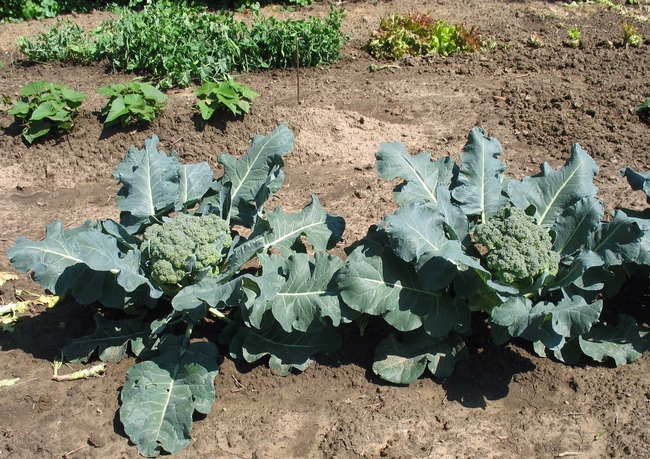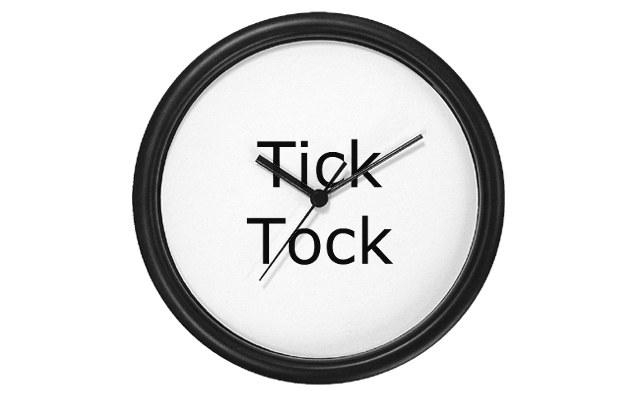While comedian Dana Carvey's song about chopping broccoli, performed on SNL in 1986, made this vegetable forever part of comedic cool, there's more to broccoli than its place in comedic history.
Be A Dear and Pass the Broccoli
As a child growing up in the 60's, I knew broccoli only as some horrendous green, gloppy thing my mother forced me to eat. I don't recall eating fresh broccoli until my early 20's; only the frozen kind that my mom boiled to mushy limpness. Based upon my early experiences, I really despised most vegetables, unless they were chopped up in Chinese food, or covered with cheese. Cheese made almost any vegetable go down – except Brussels sprouts. But, that is another story for another time. It still makes me shudder to think about it.
Fortunately, I gave broccoli another try when I was older. I found that broccoli was rather tasty when lightly steamed and seasoned, or sautéed with a little oil and garlic. I have dining out at cafes and restaurants to thank for my change of heart about eating vegetables (sorry, Mom). Now, broccoli is one of my favorite vegetables.
Broccoli is part of the cabbage family and the flowering head is used as the vegetable. In fact, the word broccoli comes from the Italian plural of broccolo, which means "the flowering crest of a cabbage".
I look forward to the cooler weather because I know its time to grow some broccoli. Broccoli is a cool-weather crop. It can germinate in soil with temperatures as low as 40º F. Broccoli grows best when average daily temperatures are between 64 and 73 °F (that's 18 and 23 °C for the rest of the world). However, I grew my broccoli throughout the winter by placing row covers over the plants when the temperatures dipped down and we had frost.
Because broccoli does not grow well in hot weather, I can only successfully grow broccoli in the late fall through early spring. In cooler parts of the country, broccoli can easily grow from early fall to mid-summer.
Last year, I planted my broccoli in late September and harvested it until late March, when the weather turned too warm and the broccoli began to bolt ("Bolt" meaning to flower, not "bolt," as in to quickly run away). This year, the hot days continued through November, so I had to plant a little later.
If you haven't grown broccoli before, it's much bigger than what you see in the store. In the garden, it grows about 2-1/2 feet high, and has large flower heads on branches sprouting from a thick stalk, which is surrounded by leaves that branch out approximately 8-12 inches wide. It will take up a bit of space in your garden, but it's worth it.
Growing The Stuff
Did you know? Broccoli is the result of careful breeding of cultivated leafy Cole crops in the Northern Mediterranean in about the 6th century BC. Italian immigrants brought it to the United States. For that, I say, Ben Fatto! to my italian ancestors.

I have found Broccoli an easy vegetable to grow. However, I've heard from friends that their plants will grow but the florets won't develop. There are two things to consider: (1) the broccoli just isn't ready yet - it can take a long, long, time for broccoli to mature - up to 3 months (maybe more); and (2) perhaps too much nitrogen or a calcium deficiency is to blame. Make sure to test your pH before planting. You'll want your soil a bit acidic.
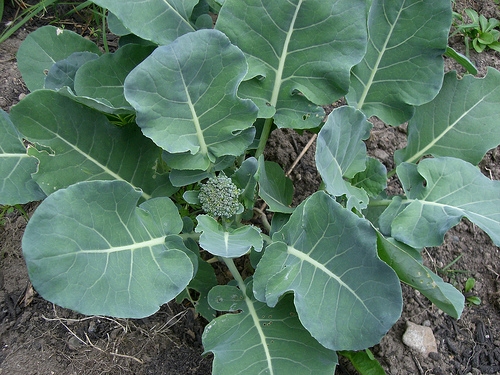
According to the Old Farmer's Almanac:
- Broccoli can germinate in soil with temperatures as low as 40º F.
- Broccoli requires full "sun" (full daylight – no shade) and moist, fertile soil. Work in 2 to 4 inches of rich compost or a thin layer of manure before planting.
- For spring plantings, seed or set transplants 2 to 3 weeks before last spring frost date. If you transplant, assume 10 less days for growth or the "days to maturity" on the seed packet.
- For fall plantings, seed 85 to 100 days before your average first fall frost. If you live in a warm climate, a fall planting is best, as broccoli thrives in cool weather. Plant seeds in mid- to late summer in most places [DWG Note: I plant broccoli starts rather than seeds so I push the planting to a later date].
- Plant seeds 1/2-inch deep, or set transplants slightly deeper than they were grown originally.
- If you overseed, you will need to thin seedlings to 12 inches apart to give room for the broccoli to grow.
- Within a row, space your plants 12 to 24 inches apart with 36 inches between each row.
- Space plants 12 to 24 inches apart, depending on the side heads you want to harvest.
- Fertilize three weeks after transplanting.
- Provide consistent soil moisture with regular watering, especially in drought conditions (not such an issue in the fall/winter months). Some varieties of broccoli are heat tolerant, but all need moisture.
- Do not get developing heads wet when watering.
- Roots are very shallow, do not cultivate. Suffocate weeds with mulch.
- Mulch will also help to keep soil temperatures down.
The Harvesting of Broccoli: Finally!
"All Good Things Come To Those Who Wait" is an apt truism when it comes to growing and harvesting broccoli. Broccoli is not the type of vegetable to give you instant gratification. Broccoli makes you wait. . . and wait. . . and wait.
There are many who give up thinking that their crop is a bust because the leaves get big, but no florets are seen. But, that's just broccoli taking it's own sweet time. You can't hurry love, you can't hurry a kettle to boil, and you can't hurry broccoli to harvest.
While doing my research for this post, I found a wonderful entry at NWEdible.com, that does a great job at explaining - far better than I can - when and how to harvest broccoli. It has great photos showing what the broccoli should look like at different stages of growth. (very cool).
Click here for the blog post → http://www.nwedible.com/2012/09/harvest-broccoli-cauliflower.html
For those not wanting to click at the moment, here is quick rundown of how to harvest broccoli:
- Harvest broccoli when the buds of the head are firm and tight before the heads flower. You'll know if the heads are starting to flower, because you'll notice some yellow beginning to peek through.
- For best taste, harvest in the morning before the soil heats up.
- Most varieties have side-shoots that will continue to develop after the main head is harvested. You can harvest from one plant for many weeks, in some cases, from fall to spring.
- Cut heads from the plant, taking at least 6 inches of stem. Make sure to leave some stem so side-shoots form.
- Cut the stalk of the main head at a slant, about 5 to 8 inches below the head. Why? Because it helps the rain to run off the stalk and lessens the chance of rot or pest infestation in the plant.
- Store broccoli in the refrigerator for up to 5 days. If you wash before storing, make sure to dry it thoroughly.
- Broccoli can be blanched and frozen for up to one year.
Insectopia and Other Apocalyptic Possibilities: Cole Crop Cabbageworm
I have never been a bug lover. As a kid, I ran willy-nilly from dive-bombing bees flailing my arms in an attempt to ward then off from stinging me. I was also known to let out blood curdling screams, while tearfully, and shrilly, demanding that my father come and kill a spider that had found its way into our house. I developed a bit of a phobia about insects and hypothesized that the only thing preventing insects from world domination over humankind was their small size. I really think we dodged a bullet on that one.

So, one of the hardest things for me about gardening is to tolerate insects. During the Master Gardener course, one of the classes was on entomology. It was a hands-on lecture. The speaker, Emma Connery, would place a plant under the microscope and project it up on a big screen, while samples of the same plant would be passed around for each us to look at through our magnifying loops. Who knew that there were so many tiny insects crawling around, too small for us to see with the naked eye? Well, thanks to that class, I do. There was a point during the Master Gardener course that I considered purchasing latex gloves so as to avoid actually touching the insects. There was also a point where I think I might have thrown up a little bit in my mouth when I put the loop to my eye, brought a plant sample up close to look at, and realized that there were swarms of nano insects just inches from my face.
Once I realized there were so many teeny insects living on our plants, I took my loop and made the rounds in my yard to determine just what I was up against. *Sigh*
I've had to develop a thick skin when it comes to insects in order to effectively garden. I learned that there are beneficial insects (that took a lot of evidence to convince me, but it finally did), along with the pests, and that we want to invite and encourage the beneficials into our outdoor spaces. I no longer freak out when I see bees – instead, I pretend I am Dr. Doolittle and welcome them with open arms (sans flailing). I also made a pact with the spiders – they stay out of my house, and I don't kill them out in my yard, except black widows (I should note here that my husband will not kill spiders for me; he will, however, catch the spider and place it gently outside. He is obviously a better person than me.)
This meandering preamble of my previous fear of all things insect, brings me to Cole crops and the pests that love them (sounds like a new Bravo TV reality series).
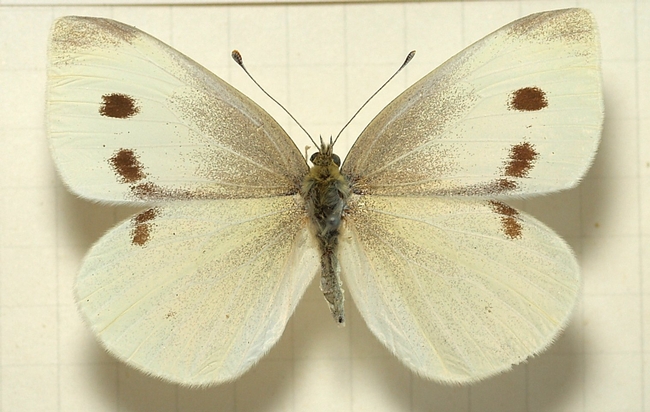
There are a number of pests that love Broccoli and other cabbages. But the most common among them is the cabbageworm. The cabbageworm is the larvae of the small white cabbage butterfly. You've seen it. It flitters among your crops looking so angelic and lovely, as it surreptitiously lays its multitude of eggs. The cabbageworms will eat your broccoli. In fact, they can disseminate a crop. It's important to take care of them, or they will take care of your crop. I had them last year, and again this year. Because of the mild weather here, they've done a little more damage. Grrr.
Although there was a split second that I was tempted to use a flamethrower to kill the suckers, I did not. I remembered my Master Gardener training, and my newly acquired appreciation for the insect circle-of-life, and resisted. Instead, I treated the problem organically.
The 100% organic and least environmentally impactful method of controlling cabbage worms is to: (a) place floating row covers over your crops to (mostly) prevent the white butterfly from laying its eggs the plants, and (b) handpick the worms off the underside of the leaves and then kill them (yes! just squish those suckers!) or toss them into your curbside compost can.

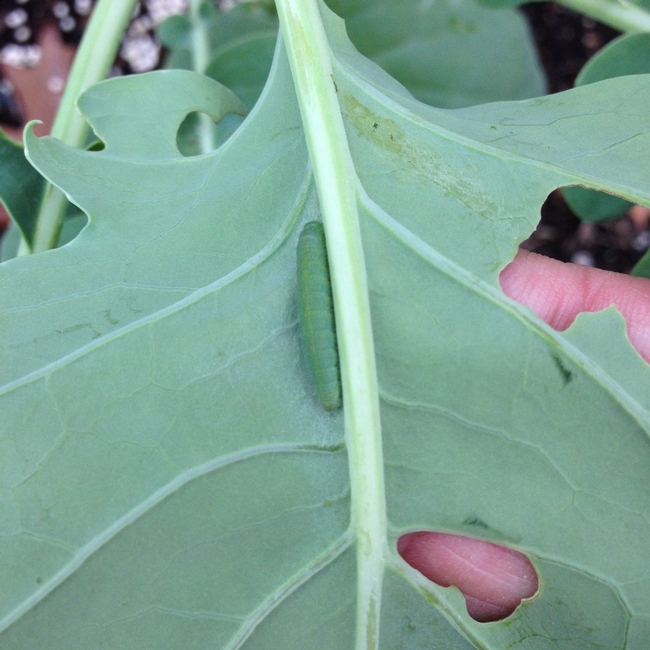
Another organic way, but minimally impactful to the environment, is to kill the worms using a biological control such as Spinosad. Spinosad is considered an organic pesticide and has a very low toxicity. It kills specific pests through contact and ingestion. Spinosad is derived from a naturally occurring soil dwelling bacterium and approved for both organic farming and home use. Spinosad does not significantly impact beneficial insects, and can be sprayed up to 24 hours before harvest of Cole crops; to protect bees, spray in the late evening, night or early morning (note: the timing depends on the crop – so read the label).
What not to use is a broad-range pesticide on your Cole crops. Even though I fully understand why you would want to be done with all of those pests in one, big fell swoop – please don't. Broad-range pesticides can be very harmful. Why? Because broad-range kills indiscriminately – meaning it kills not only the pests but also beneficial insects such as bees or parasitic wasps. There are insects that we want, and need, to keep alive and thriving in our environs. A broad-range pesticide can upset the "checks-and-balances" of nature – such as wiping out one pest only to have another, more harmful pest explode in numbers because its natural enemy was wiped out.
Remember, the only thing stopping the insects from taking over the world is their size, so let's make sure we don't dose them with any gene-mutating chemicals that could create a shift in the power paradigm. I know, it's just a hypothesis, but . . .
For more about Broccoli, check out http://www.ipm.ucdavis.edu/PMG/GARDEN/VEGES/broccoli.html


